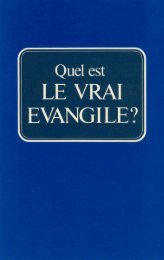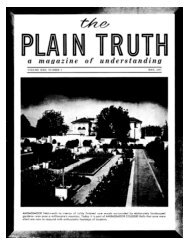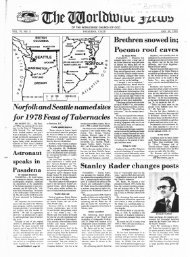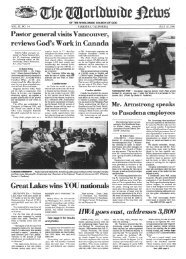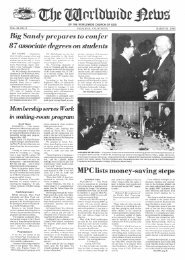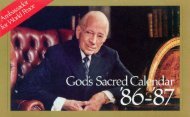The Biblical Basis of the Sacred Calendar Part One
The Biblical Basis of the Sacred Calendar Part One
The Biblical Basis of the Sacred Calendar Part One
Create successful ePaper yourself
Turn your PDF publications into a flip-book with our unique Google optimized e-Paper software.
used) from Abib/Nisan to Tishri, in order to make <strong>the</strong>m conincide better with <strong>the</strong> various lengths <strong>of</strong><br />
<strong>the</strong>se months (29-30 days). This also makes <strong>the</strong> graph coincide somewhat better with <strong>the</strong> actual<br />
relationship between <strong>the</strong> length <strong>of</strong> <strong>the</strong> lunar year and that <strong>of</strong> <strong>the</strong> solar year. However, <strong>the</strong> seasons in<br />
this graph are all <strong>the</strong> same length, which is not true in <strong>the</strong> actual solar year.<br />
25. Currently, <strong>the</strong> sequence <strong>of</strong> leap years in a 19-year cycle is: 3, 6, 8, 11, 14, 17 and 19. In Jesus'<br />
day (as confirmed by astronomical calculations), <strong>the</strong> sequence <strong>of</strong> leap years was: 2, 5, 7, 10, 13, 16<br />
and 18. Notice that in Jesus' day, <strong>the</strong> pattern was shifted back one year relative to <strong>the</strong> sequence in<br />
use today.<br />
26. As it is claimed: "<strong>The</strong> gradual regularizing <strong>of</strong> <strong>the</strong> intervals <strong>of</strong> intercalation had to be in terms <strong>of</strong><br />
<strong>the</strong> seven-year sabbatical cycle as none <strong>of</strong> <strong>the</strong> styles <strong>of</strong> <strong>the</strong> 19-year Metonic cycle would have been<br />
compatible with <strong>the</strong> rule not in intercalate in sabbatical and post-sabbatical years..." ("<strong>Calendar</strong>",<br />
Judaica, col. 49.) By contrast, Arthur Spier alleges: "[<strong>The</strong> Jubilee Years] were counted, according to<br />
Maimonides [a famous 12th-century codifier <strong>of</strong> biblical and Talmudic laws], only as long as <strong>the</strong><br />
Temple was in existence....<strong>The</strong> 7-year cycles, also called <strong>the</strong> Shemittah or release year periods, are<br />
counted, according to Maimonides and to our present custom, from <strong>the</strong> year 3829 on [in <strong>the</strong> Hebrew<br />
calendar], <strong>the</strong> year <strong>of</strong> <strong>the</strong> destruction <strong>of</strong> <strong>the</strong> Second Temple which was a Shemittah year [emphasis<br />
mine]. Every year that leaves <strong>the</strong> remainder zero when divided by seven is a seventh or Shemittah<br />
year" (<strong>The</strong> Comprehensive Hebrew <strong>Calendar</strong>, pp. 21-22). Moreover, Spier asserts <strong>the</strong> year 3829 in<br />
<strong>the</strong> Hebrew calendar is actually 69 A.D., not 70 A.D. (op. cit., p. 21). <strong>The</strong> problems <strong>of</strong> chronology<br />
associated with such claims are left to be discussed elsewhere. <strong>The</strong> Bible at any rate says nothing<br />
about <strong>the</strong> keeping <strong>of</strong> <strong>the</strong> Jubilee Year in Second Temple times. But could Jesus have quoted Isaiah<br />
61:1-2 (which uses imagery connected with <strong>the</strong> "acceptable year <strong>of</strong> <strong>the</strong> LORD") during an actual<br />
Jubilee Year (Luke 4:16-21)? This was apparently at Pentecost in <strong>the</strong> year 28 A.D. (Frederick R.<br />
Coulter, A Harmony <strong>of</strong> <strong>the</strong> Gospels: <strong>The</strong> Life <strong>of</strong> Jesus Christ, revised edition [York Publishing Co.,<br />
1975], pp. 44-45). Five seven-year cycles later brings us to 70 A.D., <strong>the</strong> year most scholars accept<br />
as <strong>the</strong> year <strong>of</strong> <strong>the</strong> fall <strong>of</strong> <strong>the</strong> Temple.<br />
27. <strong>The</strong> Talmudists described <strong>the</strong> Festivals as mo`adot, perhaps to distinguish <strong>the</strong>m from <strong>the</strong><br />
"appointed times" (mo`adim) during which <strong>the</strong>y fell. Yet both words are used in <strong>the</strong> Bible to describe<br />
<strong>the</strong> Festivals (1 Chronicles 23:31; 2 Chronicles 8:13).<br />
28. This solution (<strong>the</strong> only one to <strong>the</strong> "Nisan 14/15 question" that does not lead to selfcontradictions)<br />
is indicated in context by <strong>the</strong> "musical accents" as deciphered by Haik-Vantoura, and<br />
confirmed by a close examination <strong>of</strong> related biblical texts. <strong>The</strong> solution deserves an article all by<br />
itself.<br />
29. This seems to be why "for" is not put before "years" in "and for days and years". "Days" and<br />
"years" are linked in a more intimate way than are "signs" and "appointed times", grammatically and<br />
astronomically speaking.<br />
30. We cannot use modern astronomical calculations or natural history to test <strong>the</strong>se assumptions.<br />
"Nor can it be ascertained when, if ever, <strong>the</strong> moment <strong>of</strong> <strong>the</strong> molad was identical with <strong>the</strong> moment <strong>of</strong><br />
<strong>the</strong> mean conjunction since, because <strong>of</strong> <strong>the</strong> great many inequalities in <strong>the</strong> moon's movement in<br />
longitude, it is practically impossible to fix <strong>the</strong> mean position <strong>of</strong> <strong>the</strong> moon at any time" ("<strong>Calendar</strong>",<br />
Judaica, column 46.) But Genesis 1:14 indicates just such a time (as we will see): <strong>the</strong> beginning <strong>of</strong><br />
Day Four <strong>of</strong> Creation Week.<br />
31. <strong>The</strong> Talmudists argued over whe<strong>the</strong>r creation occurred in <strong>the</strong> fall or in <strong>the</strong> spring. Fall (Nor<strong>the</strong>rn<br />
Hemisphere) seems <strong>the</strong> more reasonable assumption, since most trees and grasses bear seed in<br />
<strong>the</strong> summer and fall, not in <strong>the</strong> spring.<br />
32. Until very recent times, astronomical events were reckoned noon-to-noon, while calendar days<br />
were reckoned (at least in <strong>the</strong> Hebrew calendar) sunset-to-sunset.<br />
33. We say conjunction ra<strong>the</strong>r than opposition because <strong>the</strong> lunar cycle begins with <strong>the</strong> conjunction.<br />
"And God made" <strong>the</strong> sun and moon "to divide <strong>the</strong> day from <strong>the</strong> night" and "to rule over <strong>the</strong> day and<br />
over <strong>the</strong> night"; yet six hours later, when <strong>the</strong> sun set over modern Afghanistan, <strong>the</strong> new crescent<br />
moon was probably visible for <strong>the</strong> first time.<br />
34. <strong>The</strong> full implications <strong>of</strong> <strong>the</strong> above two paragraphs are beyond this present study.




